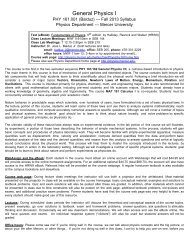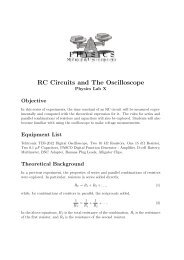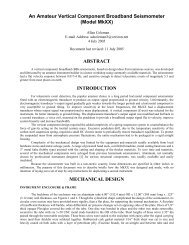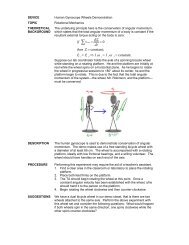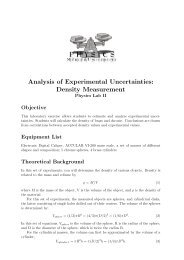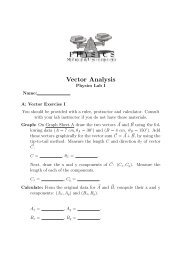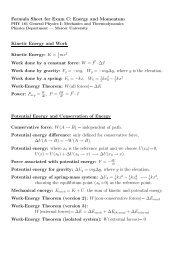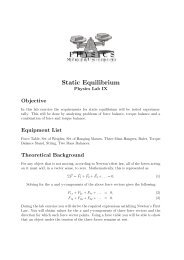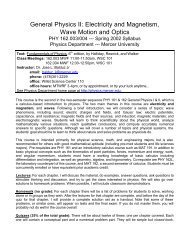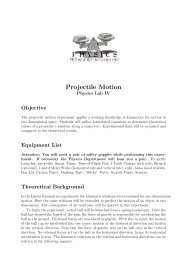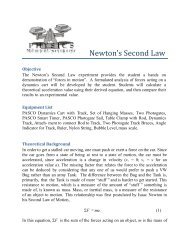Kirchhoff's Laws - Mercer University Physics
Kirchhoff's Laws - Mercer University Physics
Kirchhoff's Laws - Mercer University Physics
You also want an ePaper? Increase the reach of your titles
YUMPU automatically turns print PDFs into web optimized ePapers that Google loves.
Kirchhoff’s <strong>Laws</strong><strong>Physics</strong> Lab IXObjectiveIn the set of experiments, the theoretical relationships between the voltages and the currentsin circuits containing several batteries and resistors in a network, known as Kirchhoff’slaws, will be tested experimentally. In addition, the current within a network ofnodes will be calculated first using Kirchhoff’s <strong>Laws</strong>, and then measured experimentally.Equipment List4 ‘D’ Batteries, 3 Resistors with resistance 50 kΩ, 20 kΩ and 10 kΩ, One Multimeter,Two Battery Holders for a Single ‘D’ Battery, Battery Holder for Two ‘D’ Batteries, 8 -10 Connecting Leads, Alligator clips.Theoretical BackgroundIn previous lab experiments, the total resistance of a combination of resistors was calculatedusing the formulas for series and parallel combinations of resistors. Relationshipsbetween the current and the voltage drop across each resistor was also tested. In thesecircuits, a single battery was present. If a circuit contains more than one battery, theserelationships could not be employed. Instead, another set of relationships, known asKirchhoff’s <strong>Laws</strong>, would be used. These relationships are named in honor of the Germanphysicist Gustav Kirchhoff who discovered them.Kirchhoff’s first law states that the sum of the currents flowing through a node mustbe zero. This law is particularly useful when applied at a position where the currentis split into pieces by several wires. The point in the circuit where the current splits isknown as a node. Figure ?? illustrates a node in a typical circuit.
2 Kirchhoff’s <strong>Laws</strong>Figure 1: Current node in a circuit networkThis relationship can be expressed mathematicallyN∑I i = I 1 + I 2 + I 3 + . . . = 0, (1)i=1where I 1 , I 2 , I 3 , . . . are the current through each wire that branches from the node.For Figure ??, the Kirchhoff node equation would beI 1 + I 2 + I 3 = 0. (2)Another way of thinking of this relationship is that the current that flows into a nodemust be balanced by the current that flows out of the node (i.e. current does not buildup or leak out of a node in a circuit). This means that at least one of the currents inthe current equation will be negative and represent the current flowing out of the node.This expression is an application of the conservation of charge.Kirchhoff’s second law, which is similar to his first law, states that the sum of allvoltage drops across each electrical element (such as resistors, capacitors, batteries, etc.)in a circuit loop must be zero. A mechanical equivalent to this is a roller coaster. The carin a roller coaster is initially pulled to the top of a hill. In a circuit, this is representedby the battery placing the charges at the top of a potential ‘hill’. Once the roller coasterreaches the top of the hill, it begins to fall and move through various twists and turns.In the circuit, these twists and turns can be thought of as the various elements, suchas resistors, within the circuit. After moving through the various twists and turns, theroller coaster car ends at the bottom of the hill where it initially started. In a similarmanner, the charges in a circuit end up at the ‘bottom’ of the potential hill in a circuit.In order to sum the voltages around a loop, the voltage polarity of each object mustbe known (i.e. we must determine if the charges are ‘moving uphill’ or ‘moving downhill’in our roller coaster analogy as we go around the loop). For a battery, the polarity isusually indicated on the battery with a “+” or “-” near one of the terminals. On a circuitdiagram, the different terminals are represented by the size of the plate. The larger plateindicates a positive terminal, while a smaller plate indicates a negative terminal. Whengoing around a loop, the sign we end up on as we go across the battery is the polarity ofthe battery in the loop. Figure ?? illustrates this convention.v:F06
Kirchhoff’s <strong>Laws</strong> 3Figure 2: Battery voltage polarity conventionThe direction of current flow through a resistor determines the polarity of resistors in acircuit. For these types of problems, current is thought to be the flow of positive charges.In actuality negatively charged electrons flow, but this was not known when Kirchhoffmade his discovery. The discrepancy here does not effect the results, but should be keptin mind. If we consider the current to be made up of positive charges flowing throughthe wires, then the charges will move from higher, “+”, potential to lower, “-”, potential.Just as in batteries, the sign we end up on as we go around the loop will determine thepolarity of the resistor. This convention is illustrated in Figure ??.Figure 3: Resistor voltage polarity conventionv:F06
4 Kirchhoff’s <strong>Laws</strong>The application of these polarity conventions on the circuit shown in Figure ?? areshown in Figure ??Figure 4: Example of application of voltage polarity conventionApplying Kirchhoff’s voltage law to this circuit gives the following equations:For loop # 1,N∑V i = 0 =⇒ V B1 − I 1 R 1 + I 3 R 4 = 0, (3)i=1For loop # 2,N∑V i = 0 =⇒ −V B2 + I 2 R 2 + I 2 R 3 − I 3 R 4 = 0. (4)i=1Combining these equations with the current/node equation we obtain the following:N∑I i = 0 =⇒ I 1 + I 2 + I 3 = 0. (5)i=1Here we have three equations that describe the voltages and currents in the circuit. In atypical Kirchhoff’s laws problem, the battery voltages and the values of the resistances areknown, while the currents are not known. In this situation, the application of Kirchhoff’slaws would give several equations that could be used to solve for the currents. One voltage/loopequation is produced for each loop in the circuit. The number of current/nodeequations is typically one less than the number of voltage/loop equations.In this set of experiments, Kirchhoff voltage and current laws will be experimentallyverified for a typical circuit containing two loops. Additionally, Kirchhoff’s laws will beapplied to solve for the currents in a number of different circuits, and these current valueswill be compared to experimentally measured values.v:F06
Kirchhoff’s <strong>Laws</strong> 5Procedure and Data AnalysisVerification of Kirchhoff’s <strong>Laws</strong>Current/Node LawIn this experiment, Kirchhoff current/node law, which states that the sum of the currentsflowing into a node must be zero, will be tested experimentally.1. Using the multimeter, measure the value of the resistance of each of the threeresistors provided by setting the scale of the multimeter on the 200K scale.2. Use the multimeter to measure the voltage from the battery(s) in the single Dbattery holders and the two D battery holder.3. Set up the circuit shown in Figure ??. In this circuit, use one of the single Dbattery holder for V B1a and the two D battery holder for V B2 . For the resistors inthe circuit, use the resistors closest to the following values: R 1 = 50 kΩ, R 2 = 20kΩ,and R 3 = 10 kΩ.Figure 5: Circuit for verification of Kirchhoff’s <strong>Laws</strong>4. Set the multimeter on 200 u on the current scale (i.e. ‘the ‘A” scale). Attach ablack lead to the COM terminal and a red lead to the mA terminal. With thesesettings, the multimeter is set to read the current in the circuit in micro Amperes(i.e. µA).5. Measure the current flowing into the top node of the circuit from each of thethree branch wires. To measure the current you will have to break the circuitto insert the multimeter. You must also measure the polarity of the current ina consistent manner. If the current flows into the node, then the currentshould be measured from the positive (red/mA) terminal to the negative(black/COM) terminal. Record these measured currents on your data table.v:F06
6 Kirchhoff’s <strong>Laws</strong>6. In the space provided on the data table, add the three currents to check that thesum of the currents is zero (or close to zero).7. If your data results do not comply with theory confer your discrepancy with theLab Instructor or Lab TA.Voltage/Loop Law1. Pull the red lead out of the mA terminal on the multimeter and place it in the VΩ terminal. Set the multimeter to the 20 volt scale.2. Using the circuit shown in Figure ??, measure the voltage drops across each elementin each loop. The polarity of the voltage must be measured in a consistent manner.In order to measure the voltage in a consistent manner, always place thepositive lead (i.e. the red or V Ω lead) in front of the element, relative tothe arrow while the negative lead (i.e. the black or COM lead) is behindthe element, relative to the arrow. If this procedure causes difficulties,consult your Lab Instructor or Lab TA for assistance. Record the voltagedrop across each element, for each loop, in the space provided on the data table.3. For each loop, add the voltage drops across each element to verify that the voltageadds to zero (or close to zero). If your data results do not comply with theory,confer your discrepancy with the Lab Instructor or Lab TA.Calculation of Current Using Kirchhoff’s <strong>Laws</strong>In this series of experiments, Kirchhoff’s <strong>Laws</strong> will be used to calculate theoretical valuesof current flowing into a node. The theoretical results will be confirmed throughexperimentation.1. Using the values of the voltages from the battery holders and the resistance ofthe resistors, apply Kirchhoff’s <strong>Laws</strong> to one of the circuits shown in Figure ?? togenerate the voltage and current equations for the circuit. Each person in a labgroup should choose a different circuit to work with. Each person should chooseonly one circuit. There may be some circuits in the figure that are not used. If youhave trouble generating the equations, consult with the members of your lab groupor with the Lab Instructor or Lab TA.2. Using these equations, solve for the current flowing into the top node of the circuit.If you have trouble solving for the currents, consult with the members of your labgroup or with the Lab Instructor or Lab TA.3. Record the theoretical values of the currents in the space provided in the data table.4. Set up each circuit and measure the current through the node at the top of thecircuit. In these circuits, use the single D battery holder for V B1a and the two Dbattery holder for V B2 . For the resistors in the circuit, use the resistors closestto the following values: R 1 = 50 kΩ, R 2 = 20kΩ, and R 3 = 10 kΩ. Record theexperimental values of the currents in the space provided.v:F06
Kirchhoff’s <strong>Laws</strong> 75. For each current, calculate the percent difference between the theoretical and theexperimental values of the current. Record these values in the space provided.6. Repeat this process for the circuits shown in figure ??. Each person within a labgroup should choose a circuit from the assortment of both cases and individuallyproduce all required data for the circuits analyzed. It is not necessary to analyzeevery circuit. Be sure to include a sketch of the analyzed circuit in the spacesprovided on the data table.Selected Questions1. For the following circuit, set up the appropriate number of current/node equationsand voltate/loop equations on a separate sheet of paper. Do not attempt toevaluate the current values.v:F06
8 Kirchhoff’s <strong>Laws</strong>Figure 6: Circuits for current prediction from Kirchhoff’s <strong>Laws</strong>: Case 1v:F06
Kirchhoff’s <strong>Laws</strong> 9Figure 7: Circuits for current prediction from Kirchhoff’s <strong>Laws</strong>: Case 2v:F06



